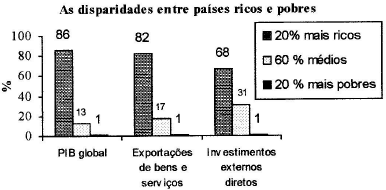“O planeta chega às vésperas de um novo século com “desigualdades mundiais na renda e níveis de vida de proporções grotescas”. É o que informa a edição 1999 do Relatório sobre o Desenvolvimento Humano preparado pelo Pnud (Programa das Nações Unidas para o Desenvolvimento), tomando como base dados relativos a 1997 para 174 países.”
Fonte: Jornal Folha de São Paulo, 11 Jul 1999.

O gráfico ao lado demonstra algumas dessas disparidades. A análise do mesmo nos permite afirmar que
- A) de cada US$ 1.000,00 produzidos no mundo, apenas US$14,00 não são gerados no grupo de países mais ricos.
- B) mais de 2/3 da produção mundial ocorre no grupo dos países citados como os mais ricos do mundo.
- C) o volume das riquezas produzidas internamente no grupo de países médios é menor que o total de bens e serviços exportados por eles mesmos.
- D) o grupo de países médios possui reduzido PIB pela ausência de investimentos de empresas de capital externo em seus territórios.
- E) o grupo de países mais pobres do mundo é responsável por apenas 1% da exportação de matérias-primas.
Resposta:
According to the 1999 Human Development Report prepared by the United Nations Development Programme (UNDP), the world is facing enormous income inequalities, with the richest countries holding a significant portion of the world's wealth. This report highlights the stark contrast between the rich and the poor, with the richest 20% of the population holding 86% of the global income, while the poorest 20% hold a mere 1.1%.
One of the key findings of this report is that more than 2/3 of the world's production occurs in the group of countries considered to be the richest in the world. This is illustrated by the graph, which shows the significant disparity in income distribution between the rich and the poor countries.
This phenomenon is often referred to as the "globalization of poverty," where the rich get richer, and the poor get poorer. The report also notes that the volume of wealth produced internally in the group of medium-income countries is less than the total value of goods and services exported by them.
Furthermore, the report highlights that the group of poorer countries is responsible for only 1% of the world's exports of primary materials. This indicates that the global economy is heavily skewed in favor of the rich countries, leaving the poor countries with limited opportunities for economic growth and development.
In this context, the correct answer is B) more than 2/3 of the world's production occurs in the group of countries considered to be the richest in the world. This is because the report highlights the significant concentration of wealth and production in the hands of a few rich countries, while the poor countries are left with limited resources and opportunities.
This finding is a stark reminder of the need for more equitable economic policies and practices that promote inclusive growth and reduce income inequalities between countries and within countries.

Deixe um comentário